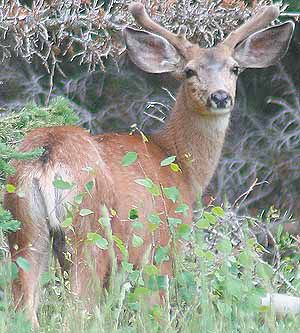| A deer in Argyle Canyon looks toward the road and the people there. |
The Utah Division of Wildlife Resources is recommending changes to its licenses and fees that would change the way hunters apply for a permit in the state’s big game drawings.
The changes would also provide the agency with some much-needed funding.
The DWR will present its recommendations at a series of public meetings that begin at the end of July.
Those who attend the meetings can learn more about the DWR’s recommendations and can provide their input and suggestions. Citizens representing Utah’s five Regional Advisory Councils will take the public input received to the Utah Wildlife Board when it meets Aug. 17 in Salt Lake City.
Any fee changes the board approves must also be approved by the Utah legislature and would not go into effect until July 1, 2007.
A proposal to establish a separate goose-hunting zone in northern Utah, and recommendations that would probably result in hunters taking about the same number of cougars in Utah this season as they took last season, also will be presented.
A meeting concerning the changes for the southeastern part of the state will take place on July 26 at the John Wesley Powell Museum in Green River. It will begin at 6:30 p.m.
A change in how the state’s big game drawing is conducted would probably result in fewer people applying for a Utah limited entry or once-in-a-lifetime big game permit.
Reducing the number of applicants would provide the remaining applicants with a better chance at drawing a permit. The proposal would also provide the DWR with some much-needed funding.
“Right now, it costs $5 to apply for a big game permit in Utah,” said Greg Sheehan, Administrative Services Section chief for the DWR. “That’s among the lowest fees in the western states, and we believe it’s one of the main reasons the number of people applying for big game permits in Utah has been climbing for years.”
While the number of applicants continues to climb, the number of permits for which to apply hasn’t changed much. For example, in 1998, more than 50,000 people applied for about 4,000 permits. In 2006, more than 144,000 people applied for about 4,400 permits.
In 1998, an average of about 13 applications were submitted for every permit that was available. By 2006, that number had climbed to an average of 32 applications per permit.
“Limited entry and once-in-a-lifetime permits are very difficult to draw in Utah. We want to make the few permits that we do have available to people who are willing to partner with us to manage the state’s wildlife,” said Jim Karpowitz, director of the DWR. “It costs a lot of money to manage the state’s big game animals. The opportunity to hunt those animals should go to the people who are willing to pay for their management.”
The DWR is recommending three options and is asking the public to choose one of them (each of these options would raise about the same amount of revenue).
•Option 1 (the DWR’s preferred option). Before applying in any draw or buying any hunting permit over-the-counter, all hunters, including big game hunters, would be required to buy a hunting license. In addition to allowing the holder to apply for a permit or buy a permit over-the-counter, a hunting license would also allow the holder to hunt small game. The license would cost $17.
•Option 2. In addition to paying the $5 application fee, big game applicants who wanted a bonus point would be required to purchase one for $24. Hunters would not have to pay for points that they had accrued in past years.
•Option 3. Hunters could apply in all five of the once-in-a-lifetime draws, and purchase one bonus point for each of the once-in-a-lifetime draws and one bonus point for the limited entry draw. The cost for each bonus point would be $12 per bonus point.
Hunters would not have to pay for points that they had accrued in past years. The application fee on all applications would remain at $5 per species.
In addition to the big game changes, the DWR is recommending some additional fee changes. One of those changes would require that those who don’t have a hunting or fishing license pay a fee to visit the state’s wildlife and waterfowl management areas (WMAs).
A Watchable Wildlife pass would be available for $10 and would allow the purchaser access to the state’s WMAs for 365 days from the day the pass was purchased. The pass would also provide the holder access to all of the Watchable Wildlife events and festivals held throughout Utah.
Karpwoitz says the DWR needs to raise more revenue. The agency is currently funded almost entirely from the sale of fishing and hunting licenses. Unless additional revenue is found, within the next five years the DWR is projecting that it will spend $11 million more than it takes in.
“To manage Utah’s wildlife effectively, we have to raise more revenue,” Karpowitz said. “If we don’t, Utah’s wildlife will suffer and so will everyone who enjoys wildlife in the state.”
In addition to input about the increased and new fees, the DWR is also seeking input about some additional items.

